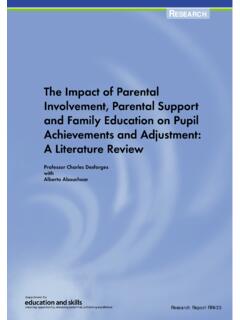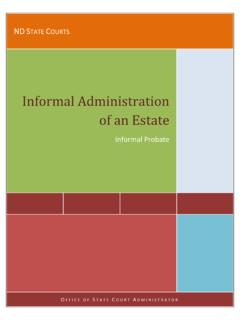Transcription of The Psychological Effects of Relocation for Children of ...
1 Vol. 15, 1998 Psychological Effects of Relocation119 The Psychological Effects ofRelocation for Children of DivorcebyMarion Gindes, I. IntroductionThe divorce of parents significantly undermines their chil-dren s sense of security and stability. The two people uponwhom the child is dependent are no longer equally accessible tothe child and the foundation of the child s world is the child s perspective, the best of all possible worlds,after parental divorce, includes parents who are amicable, do notdisplay overt hostility, can communicate with each other aboutthe child, and live close enough to each other so that child canhave the same playmates when with either These condi-tions maximize the potential for the child developing strong, pos-itive relationships with both parents as well as for both parents involvement in the child s school and extracurricular activitiesand for frequent and regular contact with the a residential or custodial parent, then, seeks to moveto a different geographic region, that best possible post-divorcescenario for Children is threatened.
2 The wish to relocate posesthe most dramatic example of the conflicting needs and wishes ofparents and Children and of the conflicting needs and wishes ofcustodial and noncustodial parents. For the most part, childrendo not wish to leave the environment in which they live nor dothey wish to leave their noncustodial parent, who also does notwant them to go. Parent and child Relocation , which has becomea major problem facing mental health and legal professionals, is,however, inevitable in a mobile society. Psychologist in private practice in New York City and Larchmont, E. Lamb et al, The Effects of Divorce and Custody Arrange-ments on Children s Behavior, Development, and Adjustment, 35 FAM. & CON-CILIATION CTS. REV. 393 (1997); Joan B. Kelly, The Best Interest of the Child: AConcept in Search of Meaning, 35 FAM. & CONCILIATION CTS. REV. 377 (1997).
3 120 Journal of the American Academy of Matrimonial LawyersPsychological research has yet to focus extensively on theimpact of Relocation on Children . Perhaps this is because reloca-tion as an issue is relatively new, too infrequent to obtain a suffi-cient sample of cases, and, of course, too geographicallywidespread to make the study of these families A vastbody of Psychological literature, however, exists regarding the re-lationship of other variables, such as interparental conflict, tochildren s well-being following parental this article, I present the major considerations involved inexamining Relocation cases, such as definitions of Relocation , psy-chological issues germane to Relocation decisions, the context inwhich Relocation occurs, and the various motivations for reloca-tion. The research dealing with Psychological factors, such as thechild s contact with the nonresidential parent, interparental con-flict, the age of the child, parent-child relationships, and the par-ents level of functioning, are discussed in terms of theirsignificance for Relocation .
4 Finally, several factors are identifiedthat are consistently related to positive adjustment in Children ofdivorce. These factors include positive adjustment of the custo-dial parent, a positive relationship between the child and custo-dial parent, and a low level of conflict between the regarding contact with the noncustodial parent havebeen found to be inconsistent and subject to wider variation thanthe other factors mentioned. The need to consider the poten-tially conflicting wishes of the child and of the parents is alsoexplored. Finally, the delicate task of reconciling the relocationissue with the best interests of the child is addressed. While thebest interests of the child standard should be a priority in anycustody decision, the larger family system cannot be neglected,especially in Relocation cases. The importance of the family con-text is acknowledged in the standards adopted by of the Associa-tion of Family and Conciliation Courts which state that the2 Judith S.
5 Wallerstein & Tony J. Tanke, To Move or Not to Move: Psy-chological and Legal Considerations in the Relocation of Children Following Di-vorce,30 FAM. 305 (1996); Leslie Ellen Shear, Life Stories, Doctrines andDecision-Making: Three High Courts Confront the Move-Away Dilemma, 34 FAM. & CONCILIATION CTS. REV. 439 (1996).Vol. 15, 1998 Psychological Effects of Relocation121primary purpose of a custody evaluation is to assess the T. Richard Saunders, Marion Gindes, James Bray, SylviaShellenberger, and Rodney Nurse note, in discussing child cus-tody assessment, the goal is to preserve what is sound and suc-cessful within any given family system..4 The needs of aparticular family member cannot be considered in isolation fromthe needs of other family Ahrons uses the term binuclear to describe thepostdivorce According to her, the binuclear family con-sists of two households, with the child living in both.
6 The binu-clear family includes stepparents, step-siblings, even formerspouses of stepparents as well as parents, full siblings and half-siblings. While this is a broad definition of the postdivorce fam-ily constellation, it highlights the interconnectedness of the vari-ous people usually continue to consider both of their parentsas part of their family, even following the parents separation ordivorce. When Children are asked to draw a picture of their fam-ily, they include both of their parents even if their parents havelong been divorced. If the interests of the entire family, whichincludes the parents, other Children , extended family members,and, sometimes, other parties who may have significant relation-ships with the Children are ignored, there may be negative conse-quences for all members of the family Thus, relocationcases, like other custody or visitation cases, need to be consid-ered from a developmental or life cycle family systems The parties need to be considered as individuals at3 ASSOCIATION OF FAMILY AND CONCILIATION COURTS, Model Stan-dards for Practice for Child Custody Evaluation, inRESOURCE GUIDE FOR CUS-TODY EVALUATORS: A HANDBOOK FOR PARENTING EVALUATIONS (1994).
7 4T. Richard Saunders et al., Should Psychotherapists be ConcernedAbout the New APA Child Custody Guidelines?31 PSYCHOTHERAPY BULL. 28(1996).5 Shear, supra note AHRONS, THE GOOD DIVORCE: KEEPING YOUR FAMILYTOGETHER WHEN YOUR MARRIAGE COMES APART (1994).7 MARION GINDES,Child Custody inHANDBOOK OF COUPLE AND FAM-ILY FORENSICS (in press).8 JAMES BRAY & SANDRA BERGER, Nonresidential Family-child Rela-tionships Following Divorce and Remarriage, in NONRESIDENTIAL PARENTING:NEW VISTAS IN FAMILY LIVING156 (1992); Maris Hetherington & W. Glenn122 Journal of the American Academy of Matrimonial Lawyersdifferent developmental stages in the context of a separatingfamily. 9 The term separating is used because a relationshipbetween the parents continues past the physical separation, di-vorce, and even remarriage. The most psychologically sound ap-proach is to determine the best interests of the family, with thechildren s interests paramount.
8 Even then, what is in the bestinterests of siblings of different ages and characteristics may notbe the Defining RelocationFrom the moment parents physically separate, greater geo-graphic distance is imposed between the Children and the non-residential parent, and their relationship changes the non-residential parent and the child, the separation inter-rupts the natural rhythm of the parent-child relationship. Non-residential parents lose the normal day-to-day contact with theirchildren, so much of which revolve around the commonplace ac-tivities of full burden of daily child care falls to the residential par-ent, who must now assume responsibilities that were the realm ofthe now-absent parent. Under the best circumstances, the child srelationship with both the nonresidential and the residential par-ent changes dramatically from the moment of parental The major Psychological task facing Children and parentsis to consolidate their relationships under the new conditions oftheir mental health professionals agree that, following sepa-ration and divorce, as few changes as possible should be made inthe lives of Children .
9 Staying in the family home, at least for sev-Clingenpeel, Coping With Marital Transitions, MONOGRAPHS OF THE SOC Y FORRES. IN CHILD DEV., 57 (1992). FLORENCE KASLOW & LITA LINZERSCHWARTZ, THE DYNAMICS OF DIVORCE: A LIFE CYCLE PERSPECTIVE (1987);Saunders et al., supra note Gindes, Competence and Training in Child Custody Evalua-tions,23 AM. J. FAM. THERAPY 272, 278 (1995).10 ELEANOR MACCOBY & ROBERT H. MNOOKIN, DIVIDING THE CHILD:SOCIAL AND LEGAL DILEMMAS OF CUSTODY (1992). 15, 1998 Psychological Effects of Relocation123eral months, often helps Children maintain a sense of stabilityand continuity, as does remaining in the same from one home to another is generally not an issuethat comes before the court. In fact, it is a frequent consequenceof divorce as parents move from the marital home to anotherresidence. When moving becomes cast as Relocation , and the res-idential parent seeks to remove the Children from the home com-munity, moving may then become a legal As A Distance ContinuumRelocation can be viewed in terms of a continuum of dis-tance between the noncustodial or nonresidential parent and thechild.
10 The implications for visitation between the nonresidentialparent and the child change significantly with the distance. Elea-nor Maccoby and Robert Mnookin found that as distance in-creased, the Children in their sample saw their noncustodialparents a few minutes apart enables the nonresidential parentto continue to be involved in the Children s lives in a more spon-taneous way. The parent can attend school functions as well aspick Children up at school. Older Children may be able to visiton their own, and dropping by for a visit is also possible. Chil-dren can have the same friends, whether they are with theirmother or father. The natural flow of the child s life does nothave to be further disrupted. Where the child and residentialparent stay in the same community, as described above, onemight consider this as a residential move but not a to Leslie Ellen Shear, once a child lives morethan twenty minutes away from the nonresidential parent, sus-taining the relationship between them necessitates fragmentingthe child s life and A move that results in a newtown, a new school, and an hour or more of traveling time, pro-duces yet another qualitative shift in the impact of the visits are no longer possible.









